In many ways, drinking Rosé is enjoying the best of both worlds. You can appreciate the dry, crisp characteristics of an aromatic white wine, paired with the bold, fruity flavours of New Zealand’s best red wines.
What is Rosé wine?
Rosé is made in a similar way to red wine, grown from red wine grapes but with less time to ferment with the grape skins. This gives Rosé its recognisable pink colouring and a much-loved lighter, crisper flavour.Where is Rosé grown?

Because of the way wine was made, most of the earliest known red wines probably had more in common with modern Rosé than today’s Pinot Noir or Cabernet Sauvignon. Because Rosé has more to do with how wine is made than a single grape variety, most of the world’s famous wine regions like France’s Bordeaux and Burgundy, or Calabria and Sicily in Italy also produce Rosé.
Rosé in New Zealand
In New Zealand, interest in Rosé is exploding. Every summer we see new labels arriving on our supermarket shelves, and sales of rosé are up 50 per cent year-on-year.

Most of the Rosé produced in the Hawke’s Bay is made using Merlot or Syrah, making it a more robust, spicy wine. Pinot Noir is Marlborough's most common Rosé, giving it intense flavours of ripe berries and stone fruit. Rosé from Central Otago is also primarily made with Pinot Noir, but the terroir and climate add flavours of cherry, strawberry, raspberry and a touch of herbs.
How is Rosé made?
Unlike Pinot Gris or Pinot Noir, Rosé is not a grape variety. No matter how many vineyards you explore, you will never find a pink grape. To nip another common Rosé misconception in the bud, you do not make pink wine by mixing red and white wine together.
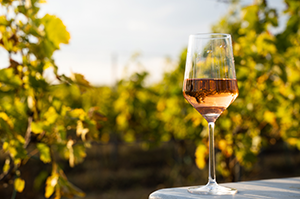
Whenever you crush a grape, either red or white, the juice comes out clear. To give a wine colour, you leave it soaking with the skin of the grape in a process called maceration.
Rosé is created by lightly crushing red grapes, and only leaving the grape juice to macerate with the red skins for a short period of time. Depending on what flavours and colour you want in your Rosé, maceration could be anywhere from a few hours to a few days. The longer the red grape skins are left soaking with the juice, the darker the finished Rosé will be. Typically, darker Rosé’s will also have more of the deeper flavours and more tannic qualities of red wine.
Rosé can be made using any red grape variety. The most common wine varietals in New Zealand are Pinot Noir, Syrah, Merlot, and Cabernet Sauvignon. Unusually, some New Zealand wine producers are making Rosé using Pinot Gris.
What does rosé taste like?
Rosé wine flavours are generally more refined versions of the grape variety used to make them. Think fruitier flavours of strawberries, raspberries and cherries, without the rich, robust, tannic influences associated with red wines.
To find New Zealand’s Rosé growers, we must look to the regions producing the most red wine. Cooler South Island regions such as Marlborough and Central Otago are well suited for Pinot Noir, Merlot and Cabernet Sauvignon.
Within the world of Rosé you will find two distinct styles. Blush Wine and Dry Rosé.
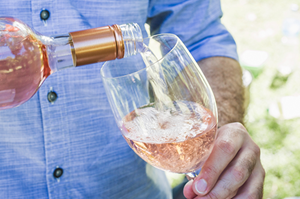
Blush rosé
Blush wines are the sweeter of the two varieties. Because they have less contact with the red grape skins, Blush Rosés are usually lighter in colour, as well as less acidic and lower in alcohol. For these reasons, Blush wines are summer crowd pleasers. The classic sweet Blush Rosé is made using Zinfandel, but other blush varietals are Merlot and Cabernet Sauvignon.
When trying a glass of Blush Rose you may find flavours of candy floss, green apple, juicy apricot and ripe melon.
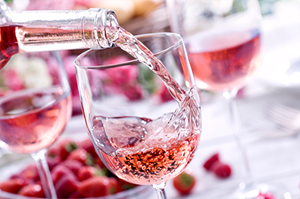
Dry rosé
Dry Rosés are less sweet, usually darker in colour, with more of the flavours associated with red wine. You’re likely to find more acidity in a Dry Rosé compared to a Blush, balanced with more intense fruit flavours.
Because of the diverse varietals used to make Dry Rosé, this group of wines varies considerably in intensity, body and flavour. Think vibrant strawberries, raspberries, dark plums and black boy peaches.
Rosé prices
The rise in popularity of Rosé, and more importantly, the increase in production of vineyards around New Zealand are driving the price of quality Rosé down.
By using the Wine Finder guide, you can find a range of great Rosé for under $25 a bottle.
Rosé compared to other wines
Want to know more Rosé? Let’s look at how it compares to some of the other wines you’ll find on the shelves of your local New World.
-
Rosé vs red wineIf you enjoy red wine, but want a cooler, more refreshing drink in summer, then Rosé is for you. It’s much lighter, and more aromatic than most red wines, while still carrying the ripe fruit flavours you love. Red wines like Merlot or Pinot Noir are famous for robust flavours, powerful tannins and thicker textures. To describe those characteristics as ‘watered down’ in Rosé is to do Rosé a disservice. It is fair to say that those powerful elements people look for in red wine are more subtle and subdued in Rosé.
-
Rosé vs white ZinfandelTechnically, white Zinfandel is Rosé. Both are produced the same way, leaving the juice from the red grapes to macerate with the skins. Two happy accidents led to the creation of white Zinfandel. In an effort to create a more intense Zinfandel, Californian winemakers skimmed some of the liquid off the top while the juice was still soaking with the skins. Secondly, a Stuck Fermentation, which is where the yeast dies before it finishes converting sugars to alcohol, led to a sweeter than usual batch. The end result was white Zinfandel, a Rosé down the very sweet end of the scale with a slightly higher alcohol content.
-
Rosé vs white wines
People unused to drinking wine usually start with white wines or Rosé because they tend to be sweet, fruity and refreshing when served cold. Aromatic white wines like Riesling and Pinot Gris share many of the same qualities as Rosé. Perfect if you love crisp, sweet flavours with a hint of acidity. However, the contact with red grape skins adds a little more body and complexity to Rosé compared to those aromatic white wines.
Best New Zealand Rosé

Get your wine delivered to your door.
Rosé nutrition per 150ml glass (1 serving)
| Calories | Carbohydrates |
| 138 per serving | 3.75g per serving |
| Alcohol | Sugar |
| On 12% Alc bottle, 1.42 standard drinks per serving | 2.5g per serving |
Storing Rosé
-
How long can you store an unopened bottle of Rosé?
With Rosé, freshest is best. Because Rosé varies from light to medium sweetness, as well as light to medium acidity, it has few of the natural preservatives that normally allow wines to mature and age.
The way New Zealand Rosé is produced celebrates its lively, fruity, fresh flavours. There’s not much to be gained by aging it.
There is no shame in drinking Rosé with the previous year printed on the label. You shouldn’t really drink Rosé that’s older than two or three years.
The exceptions to this rule are some varieties of European Rosé. A Spanish Rioja Rosé may be aged before its release, but that means they’ve done the hard work for you. The Provence wine region of France produces many red wines that are made to be cellared, and so a Provence Rosé could potentially be stored for a few years.
If you’re looking to buy and age wine, there are other varieties far better suited to cellaring than Rosé.
-
How long will an opened bottle of Rosé last?After opening your Rosé, keep it in the fridge and make sure you consume it within three days. Rosé is the perfect bottle to bring to a summer BBQ and share with your friends. When it’s lightly chilled and fresh, everyone will be able to enjoy the refreshing, fruity flavours. If you’re planning on having a glass every now and again, you may notice some unpleasant changes in your Rosé over time.
-
How to tell if your Rosé has “gone bad” ?
Rosé is famous for its stunning range of colours. From light peach to shocking pink, and even shades closer to red. Looking at the Rosé inside the bottle, if you can see more shades of brown or yellow, that’s a good indication that the wine has “gone bad.”
If you bought a still Rosé, but it looks fizzy or sparkling, it’s had a second fermentation after bottling and won’t be enjoyable to drink.
Trust your nose. If your Rosé gives off an aroma of mould, must or wet cardboard, don’t drink it. It’s gone bad.
Serving Rosé
When serving Rosé it’s best to treat it like a white wine. Make sure your Rosé is chilled first. Of all wine varieties, Rosé is probably the most seasonal, in that it tastes better in summer. The best way to serve Rosé is in a chilled glass on a warm day, while sitting outside in the sun. Doesn’t that sound perfect?
A common problem when serving Rosé is cooling it too much. Your bottle of Rosé should sit in the fridge for two hours so it’s chilled. Let the bottle stand for fifteen minutes before serving, so it’s around 10 to 12 degrees Celsius in the glass. If your Rosé is too cold, it will mask the flavours and you won’t be able to fully appreciate its deliciousness.
For the proper wine glass to best enjoy your Rosé, try a Riesling or sweet wine glass. A longer stem means your Rosé will stay colder for longer as it’s further away from the heat of your hand. A sweet wine glass is smaller than your standard wine glass and has a smaller rim, which guides the wine towards the centre and back of your mouth. The taste buds that detect sweet flavours lie towards the tip of your tongue, so directing the Rosé away from them helps you avoid an overwhelming sweet sensation from your first sip.
Want to try something a little different? Rosé is ideal for mixing in summer cocktails. The sunset colours and fruity aromas will have everyone admiring your glass. Add some mint leaves, a few slices of strawberry, ice and lemonade, and you’ve got a cold, refreshing drink to help you survive the summer heat.
Rosé pairing
The beauty of Rosé lies in its versatility. It’s less intense than a robust red, but has more body and flavour than an aromatic white.

Rosé and meat pairing
Because Rosé simply tastes better on a warm day, it’s the best wine to accompany the great Kiwi BBQ. From a humble sausage in bread with a sprinkling of onions, beef steak or chicken nibbles, Rosé works wonderfully with them all.
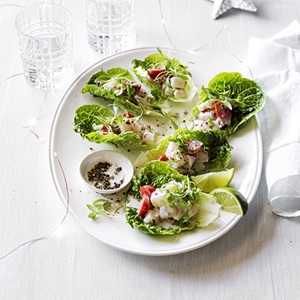
Rosé and fish pairing
Sweeter, fruitier Rosés are simply divine with seafood and citrus. For a beautiful summer brunch, prepare a platter of olives, melon, raspberries, pesto, mussels, scallops, oysters, hummus, bruschetta, cherry tomatoes, brie - and anything else you fancy - while your Rosé is chilling. Sweet summer fruits, salty seafood and cheese, served with Rosé. Yum.
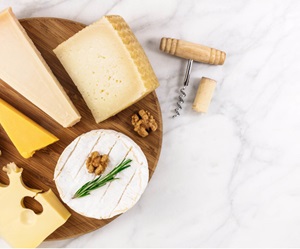
Pairing Rosé with cheese
Cheese platters and Rosé are made for each other. A dry Rosé has the acidity of a white wine with the fruity flavour profile of a red. Try a mild Gorgonzola or a creamy Monterey Jack. The earthy, nutty flavours of the cheese will be highlighted by the fruitier qualities of a Dry Rosé.
Prefer sweeter Blush Rosé? Choose saltier cheese like blue cheese, aged gouda, or feta with prosciutto, and the sweeter Rosé will provide perfect balance and harmony.
Are you looking to pair Rosé with entrees, or searching for the perfect fruity wine to bring to your next summer BBQ? The team at your local New World can help you find a delicious Rosé to suit any occasion.
Rosé - much more than a summer wine
Within the world of Rosé there is so much variation, from shades of pale peach through to “I can’t believe it’s not red.” The range of Rosé flavours within that happy medium of red and white wine means you can find a Rosé to match whatever you’re eating.


